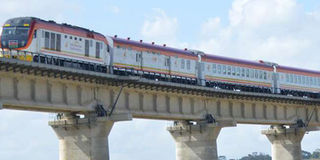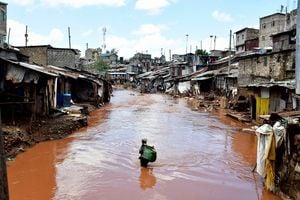SGR a key public investment to secure the country’s future

Madaraka Express passenger train in Miritini, Mombasa, on October 16, 2017. The modern railway system is entrenching itself as the nerve centre of shared industrial growth and economic prosperity. PHOTO | KEVIN ODIT | NATION MEDIA GROUP
What you need to know:
- Manufacturers will be the biggest beneficiaries as the cost of cargo transport and clearance comes down.
- The freight service will cut the number of trucks plying the corridor and create opportunities for those serving the inland ports.
In the early stages of its implementation, the Standard Gauge Railway (SGR) was perceived as any other grand public investment that would add to the stock of infrastructure, improve transportation and ease the cost of doing business for the private sector.
The modern railway system, which has been glorified and vilified in equal measure, is entrenching itself as the nerve centre of shared industrial growth and economic prosperity.
Those who see President Uhuru Kenyatta’s flagship project as a 472km railway line on which the Madaraka Express passenger trains operate between Nairobi and Mombasa, are missing the big picture.
The SGR is the transport solution and experience that has been missing since the Kenya-Uganda railway over a century ago opened up East Africa by stimulating the growth of businesses and trading centres along the Northern Corridor transport system.
MANUFACTURING
The Kenya Railways project, which started commercial operations in May, has established backward and forward linkages with the economy.
It will tug along the manufacturing sector and stimulate domestic and international trade.
Manufacturing, one of the President’s ‘Big 4’ pillars of development in his second and final five-year term, will be the greatest beneficiary of the SGR.
Though the sector is the engine of growth, it has suffered for decades from inefficiencies at Mombasa Port, which was until the SGR, the country’s most important infrastructure asset.
Industries have protested about the losses they incur daily at the port, which is the playground of cartels and corruption that cripple the Northern Corridor.
MOMBASA PORT
The Kenya Association of Manufacturers has urged the government to fix the port to save the industry from heavy import and export costs that prevent it from realising its potential — to increase its contribution to the economy from nine to 15 per cent and create jobs.
The prescriptions to solve problems at the port are well-documented but they are not sufficiently administered, or the dose may be too little to make a difference.
The government has now found a solution that creates an efficient link between the port and markets.
The centre bolt of this transformation is the SGR, which is networked with the inland container depot in Nairobi and the proposed dry port in Naivasha.
The expansion and modernisation of the inland container handling facility, which the President launched last Saturday, and the dry port, will expedite exports and imports.
CARGO TRANSPORT
The optimisation of the SGR transport chain is just beginning to unfold.
Imports no longer need to be cleared at the port.
Containers will be offloaded from ships to the SGR and cleared at the ICD or dry port.
Exports cleared at the two inland facilities will be transported by train to the port and loaded on merchant ships.
Manufacturers will be the biggest beneficiaries as the cost of cargo transport and clearance comes down.
Benefits will also come from faster transfer of cargo through SGR freight trains that will handle 22 million tons a year.
Kenyans will benefit from the expanded business opportunities, jobs and technology upgrading stimulated by the new system.
FREIGHT SERVICES
The lords of the port sense serious loss of business and influence.
Taking away a huge chunk of cargo handling and customs clearance services from the port will reduce opportunities for rent-seeking and shift trucking business inland.
Just as Madaraka Express has significantly reduced buses on Mombasa-Nairobi highway, the freight service will cut the number of trucks plying the corridor and create opportunities for those serving the inland ports.
Of the investments that will define President Kenyatta’s legacy, the SGR stands out.
The investment has pulled out the crocodile that has stubbornly prevented Kenyans from drinking from the fountain of growth and crossing the river to prosperity.
Mr Warutere is a director of Mashariki Communications Ltd. [email protected]





